
The Panzerfaust was a development family of single-shot man-portable anti-tank systems developed by Nazi Germany during World War II. The weapons were the first single-use light anti-tank weapons based on a pre-loaded disposable launch tube, a weapon configuration which is still used today.

Stielhandgranate is the German term for "stick hand grenade" and generally refers to a prominent series of World War I and World War II–era German stick grenade designs, distinguished by their long wooden handles, pull cord arming and cylindrical warheads. The first models were introduced by the Imperial German Army during World War I and the final design was introduced during World War II by the German Wehrmacht.
A rifle grenade is a grenade that uses a rifle-based launcher to permit a longer effective range than would be possible if the grenade were thrown by hand.
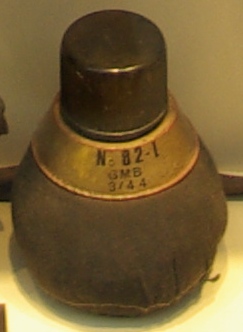
The Gammon bomb, officially known as the No. 82 grenade was a British hand grenade used during World War II.
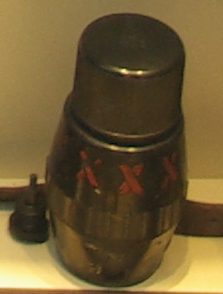
The British No. 69 was a hand grenade developed and used during the Second World War. It was adopted into service due to the need for a grenade with smaller destructive radius than the No. 36M "Mills bomb". This allowed the thrower to use a grenade even when there was little in the way of defensive cover. In contrast, the much greater destructive radius of the Mills bomb than its throwing range forced users to choose their throwing point carefully, in order to ensure that they would not be wounded by the shrapnel explosion of their own grenade.

The Grenade, Rifle No. 68 / Anti-Tank was a British anti-tank rifle grenade used during the Second World War and was one of the first operational weapons to utilise the shaped charge principle.

The Grenade, Hand, Anti-Tank, No. 75, also known as the "Hawkins grenade" was a British anti-tank hand grenade used during World War II. It was one of a number of grenades developed for use by the British Army and Home Guard in the aftermath of the Dunkirk evacuation. The grenade first appeared in 1942, and was designed to be more versatile than previous grenades, such as the No. 73 grenade and the sticky bomb.

The "Grenade, Hand, Anti-Tank No. 74", commonly known as the S.T. grenade or simply sticky bomb, was a British hand grenade designed and produced during the Second World War. The grenade was one of a number of ad hoc anti-tank weapons developed for use by the British Army and Home Guard after the loss of many anti-tank guns in France after the Dunkirk evacuation.
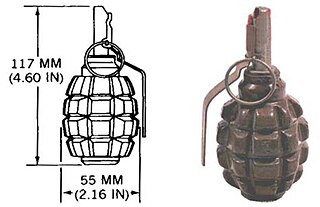
The Soviet F-1 hand grenade is an anti-personnel fragmentation defensive grenade. It is based on the French F1 grenade and contains a 60 g (2.1 oz) explosive charge (TNT). The total weight of the grenade with the fuze is about 600 g (21 oz).
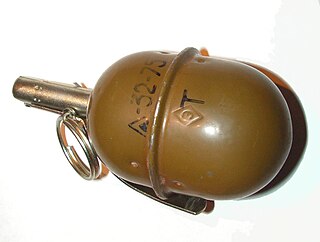
The RGD-5 is a post–World War II Soviet anti-personnel fragmentation grenade, designed in the early 1950s. The RGD-5 was accepted into service with the Soviet Army in 1954. It was widely exported, and is still in service with many armies in the Middle East and the former Soviet bloc.
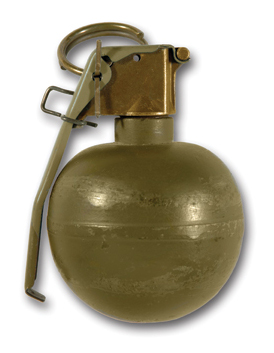
The M67 grenade is a fragmentation hand grenade used by the United States military. The M67 is a further development of the M33 grenade, itself a replacement for the M26-series grenades used during the Korean and Vietnam Wars, and the older Mk 2 "pineapple" grenade used since World War I.

The Mk 2 grenade, also nicknamed the Pineapple is a fragmentation-type anti-personnel hand grenade introduced by the U.S. armed forces in 1918. It was the standard issue anti-personnel grenade used during World War II, and also saw limited service in later conflicts, including the Korean War and Vietnam War. Replacing the failed Mk 1 grenade of 1917, it was standardized in 1920 as the Mk II, and redesignated the Mk 2 on April 2, 1945.

The Type 89 grenade discharger, inaccurately and colloquially known as a knee mortar by Allied forces, is a Japanese grenade launcher or light mortar that was widely used in the Pacific Theater of World War II. It got the nickname the "knee mortar" because of an erroneous Allied belief that these launchers could be fired by propping its plate against the leg. However, anyone trying to fire it this way would receive a severe bruise from its hefty recoil.
The Type 10 grenade was the first fragmentation hand grenade designed and deployed by the Imperial Japanese Army.

The No. 73 grenade, also known as the "Thermos", "Woolworth bomb", or "hand percussion grenade", was a British anti-tank grenade used during the Second World War. It got its nickname from the resemblance to a Thermos flask.
The military of the United States has used many different types of hand grenades since its foundation.
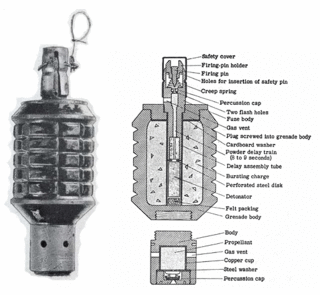
The Type 91 hand grenade was an improved version of the Type 10 fragmentation hand grenade/rifle grenade of the Imperial Japanese Army. Although superseded as a hand-thrown weapon by the Type 97 by the start of World War II it was still used by units in the Second Sino-Japanese War and by reserve forces, as well as the Japanese Navy's Special Naval Landing Forces.

The HG 85 is a round fragmentation hand grenade designed for the Swiss Armed Forces, and is still produced by RUAG Ammotec in Switzerland. HG 85 is the internal designation of the Swiss Army and replaced the HG 43 from World War II.

The F1 grenade is manufactured by Thales Australia exclusively for the Australian Defence Force as a primary defensive anti-personnel hand grenade.

A grenade is an explosive weapon typically thrown by hand, but can also refer to a shell shot from the muzzle of a rifle or a grenade launcher. A modern hand grenade generally consists of an explosive charge ("filler"), a detonator mechanism, an internal striker to trigger the detonator, an arming safety secured by a transport safety. The user removes the transport safety before throwing, and once the grenade leaves the hand the arming safety gets released, allowing the striker to trigger a primer that ignites a fuze, which burns down to the detonator and explodes the main charge.















